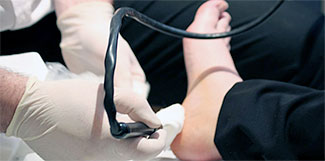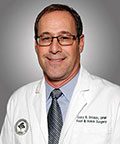- Home
- Advanced Treatments
- Cryotherapy
Cryotherapy for Morton's Neuroma and Plantar Fasciitis
- Published 11/27/2018
- Last Reviewed 2/5/2025

What is cryotherapy ablation?
Cryotherapy (also known as cryosurgery or cryoablation) is a state-of-the-art treatment that uses extremely low temperatures to painlessly destroy nerve tissue. Cryotherapy nerve blocks stop the transmission of pain signals to the brain and relieve pain.
Despite its benefits, cryotherapy is not widely offered by foot and ankle practices. The main barrier is the high cost of the cryotherapy machine and its specialized equipment, making it a significant investment. Additionally, performing the procedure requires specialized training and expertise, further limiting its availability. UFAI is proud to offer cryotherapy at its Santa Monica location.
- What foot conditions does cryotherapy ablation treat?
- How does cryotherapy for Morton's neuroma work?
- What to expect during cryotherapy nerve ablation?
- What to expect after cryotherapy ablation?
- Are there risks with cryotherapy?
- Why trust University Foot and Ankle Institute for cryotherapy near me?
- Cryotherapy FAQs
- What type of sedation is used during nerve ablation?
- What happens if nerve ablation doesn't work?
- What is the success rate of cryotherapy for Morton's neuroma treatment?
-
ABFAS® Board Certified in Foot and Ankle Surgery and Co-Director of University Foot and Ankle Institute
Board-Certified Podiatric Foot and Ankle Specialist, Dr. Gary Briskin, DPM, FACFAS, began his medical training by serving a residency at Flint General Hospital in Michigan. Once completed, he established a practice in Century City Hospital, where he soon became chief of podiatric surgery.
Dr. Briskin is a Diplomat of the American Board of Podiatric Surgery and a Fellow of the American College of Foot and Ankle Surgeons. He also serves as an assistant clinical professor at the UCLA School of Medicine and is co-founder and co-director of University Foot and Ankle Institute.
 Great doctors and very helpful staff.Hellia B.
Great doctors and very helpful staff.Hellia B. Please provide handicap parkingBarry S.
Please provide handicap parkingBarry S. Dr. Ambibola Johnson is awesome!Laurie S.
Dr. Ambibola Johnson is awesome!Laurie S. I appreciate the care and timeliness of all my appointments I’ve had at UFAI. Gray, Lydia and the staff all are wonderful. Lydi...Edelmira G.
I appreciate the care and timeliness of all my appointments I’ve had at UFAI. Gray, Lydia and the staff all are wonderful. Lydi...Edelmira G. Very greatfull for the doctor and stuffJesus M.
Very greatfull for the doctor and stuffJesus M. Doctor was very caringBrigitte S.
Doctor was very caringBrigitte S. Dr. Baravarian and his staff were very helpful and extremely courteous. Impressive practiceHolly C.
Dr. Baravarian and his staff were very helpful and extremely courteous. Impressive practiceHolly C. Everyone is very nice and efficient-
Everyone is very nice and efficient-
Especially Dr Kelman. He takes very good care of me!!Claudia K. Great costumer service.
Great costumer service.
Prompt and efficientDean W. No . I’m pleased with the care .Michael P.
No . I’m pleased with the care .Michael P. Top-notch patient services in a comfortable and accessible setting. Appointments can be made online or over the phone. I saw Dr...Brittany B.
Top-notch patient services in a comfortable and accessible setting. Appointments can be made online or over the phone. I saw Dr...Brittany B. Appreciate the professionalism and expertise, as well as the caring.Stella G.
Appreciate the professionalism and expertise, as well as the caring.Stella G.
